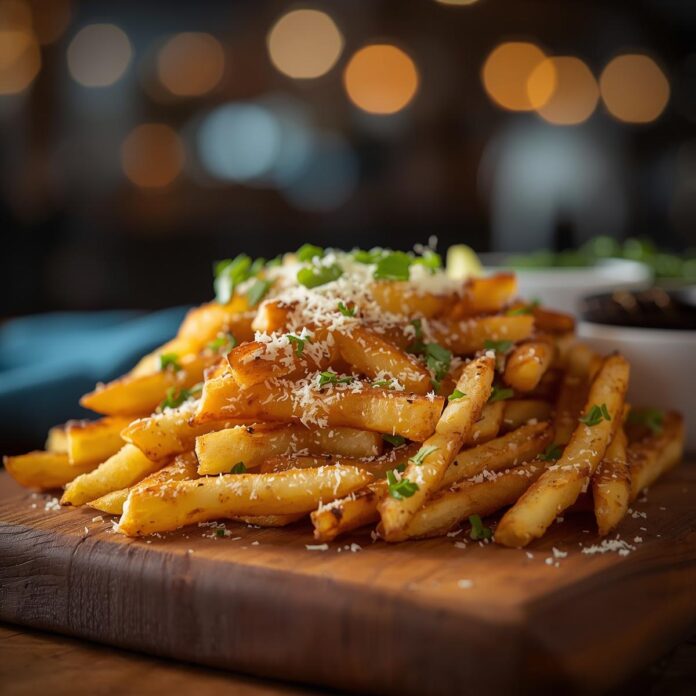Few dishes capture the spirit of comfort, versatility, and culinary ingenuity quite like fried rice. What began as a humble method of repurposing leftover rice has evolved into a global staple, celebrated in countless variations from bustling street food stalls to elegant restaurant tables. Each culture has its own interpretation, yet the essence remains unchanged—a symphony of textures and flavors brought together in a single sizzling pan. Among these variations, one version stands out for its balance of depth, richness, and aromatic satisfaction: Savory Onion Beef Fried Rice. This dish unites the tender, umami-laden savor of marinated beef with the gentle sweetness of caramelized onions and the fragrant base of perfectly seasoned rice, yielding a meal that feels both hearty and harmonious.

At its core, fried rice is a study in balance. It’s a dance between the simplicity of ingredients and the complexity of flavor, between tradition and adaptation. What makes Savory Onion Beef Fried Rice distinct is the interplay between the sweetness and slight sharpness of onions—an ingredient often underestimated—and the deep, satisfying richness of well-seared beef. The onions provide not only sweetness but also a natural moisture and aromatic base that permeates the entire dish. When combined with tender beef slices, lightly charred yet juicy, the result is a layered flavor experience that unfolds gradually: first the savory soy undertones, then the nutty aroma of sesame oil, followed by the subtle sweetness of caramelized onions that linger just long enough to invite another bite.
The origins of fried rice trace back over a thousand years to China’s Sui Dynasty, where rice was a dietary staple and nothing was wasted. Leftover grains, slightly dried from the previous day, became the foundation for a quick, nourishing meal when tossed in a hot wok with vegetables, eggs, and bits of meat. Over centuries, this practice spread throughout Asia and beyond, adapting to local ingredients and culinary traditions. In Japan, it became chāhan, characterized by clean flavors and precision; in Thailand, khao pad, defined by the bold interplay of fish sauce and aromatics; and across Western kitchens, fried rice took on new forms to accommodate regional palates. The Savory Onion Beef variation draws its inspiration from these traditions while introducing a distinct depth that appeals to both classic and contemporary tastes.
The onion, though often considered a supporting character in cooking, plays a starring role here. When treated properly—sliced thinly and cooked just to the edge of caramelization—it transforms the base of the dish into something extraordinary. Its natural sugars mellow the salinity of soy sauce and balance the richness of beef fat. Each slice softens and browns, releasing a fragrance that infuses the oil, rice, and protein alike. This transformation is not just about taste, but chemistry: the Maillard reaction between amino acids and reducing sugars creates hundreds of flavor compounds, lending complexity and warmth to every spoonful.
The beef, meanwhile, introduces a textural contrast and satisfying substance. Whether flank steak, sirloin, or tenderloin, the key lies in slicing the meat thinly against the grain and marinating it just long enough to infuse flavor without sacrificing tenderness. A well-prepared marinade—built from soy sauce, oyster sauce, garlic, and a touch of sugar—imparts depth and gloss. When seared over high heat, the beef caramelizes at the edges, creating savory notes that echo the onions’ sweetness while locking in juices. The key to perfect balance lies in timing: cooking the onions until golden before adding the beef ensures that both elements reach their peak flavor without overpowering the other.
The rice itself—humble, fragrant, and deceptively simple—is the canvas upon which this dish is built. The ideal rice for fried rice is day-old, allowing individual grains to separate and fry rather than steam. Each grain should be lightly coated in oil and sauce, yet retain its integrity, offering a subtle chew that contrasts with the tender beef and soft onions. Achieving this texture requires control over moisture and heat. Too much liquid results in sogginess; too little heat prevents proper browning. Mastery comes from understanding the wok’s behavior—the way oil spreads across its surface, the sound of sizzling grains, and the brief moment when aroma signals that everything has come together perfectly.
But beyond technique and chemistry, Savory Onion Beef Fried Rice carries emotional resonance. It represents the ingenuity of turning simple ingredients into something deeply satisfying, a culinary expression of thrift, comfort, and creativity. It’s a dish that feels at home in both a family kitchen and a professional setting—a weeknight favorite that can be transformed into a gourmet presentation with only a few refinements. Each element contributes not only to taste but to narrative: the rice, representing sustenance and foundation; the beef, symbolizing richness and heartiness; and the onions, embodying transformation and balance.
This dish also exemplifies the power of layering flavors. The foundation begins with aromatics—onions, garlic, and sometimes scallions—followed by protein and finally rice. The sequence matters, for each addition builds upon the last, absorbing the seasonings and forming a cohesive whole. Sauces are introduced at just the right moment to coat without drowning, and the final stir—quick, deliberate, rhythmic—ensures even distribution and a gentle char that only a properly heated pan can deliver. In the end, what emerges is more than the sum of its parts: a fragrant, glistening bowl that satisfies on every sensory level.
In the chapters ahead, we will explore every layer of this dish—from ingredient selection and preparation techniques to the cultural and scientific principles that shape its flavor. We’ll discuss the role of rice type and texture, the importance of heat management, and the subtleties of achieving a perfect onion-to-beef ratio. We’ll also delve into flavor science—the umami interactions between soy, beef, and caramelized onion—and how they create that elusive “savory depth” that defines great fried rice. Alongside the core recipe, we’ll examine variations, pairing ideas, and troubleshooting tips to help you adapt this dish to your own kitchen and taste.
By the time you finish this guide, you will not only understand how to make Savory Onion Beef Fried Rice but also why each step matters. You will learn to trust your senses—the hiss of the wok, the sheen of properly fried rice, the aroma of caramelizing onions—as the most reliable tools in the kitchen. Ultimately, this dish is more than a recipe; it’s an invitation to connect with the universal joy of transforming simple ingredients into extraordinary meals.
Detailed Instructions
Preparation and Ingredient Foundations
Cooking exceptional Savory Onion Beef Fried Rice begins long before the wok is set over the flame. The success of this dish depends on careful selection, preparation, and understanding of each ingredient’s role. Every element—from the rice grains to the slices of beef and onions—contributes to the dish’s final character. This section covers each component in depth to ensure consistency, flavor, and authenticity.
1. Choosing the Right Rice
The rice is the soul of any fried rice dish. The best texture is achieved with rice that has been cooked, cooled, and stored for at least one day. Freshly steamed rice, still moist and clumpy, releases too much steam in the wok, resulting in a mushy consistency.
Recommended Rice Type:
-
Medium- or long-grain white rice (such as jasmine or basmati).
-
Jasmine rice provides a delicate aroma and slightly chewy texture.
-
Basmati rice, while longer and drier, yields a crispier finish when fried.
-
Preparation Tip:
-
Cook the rice the day before using slightly less water than usual (about 90% of the standard ratio).
-
After cooking, spread it on a tray to cool and refrigerate overnight.
-
Before cooking, break apart any clumps with your fingers or a fork to ensure even frying.
Why it matters:
Day-old rice has reduced surface moisture, allowing the grains to fry individually rather than steaming together. This separation is what gives fried rice its characteristic texture—light, slightly chewy, and full of flavor.
2. Selecting and Preparing the Beef
Beef provides the savory depth and richness that define this version of fried rice. The goal is tender, flavorful slices that caramelize quickly under high heat.
Ideal Cuts:
-
Flank steak: lean, flavorful, and tender when sliced thinly.
-
Sirloin or ribeye: more marbled, providing added richness.
Preparation:
-
Slice the beef thinly against the grain—about 1/8 inch thick. Cutting against the grain shortens muscle fibers, producing a tender bite.
-
Place slices in a bowl and add:
-
2 tablespoons soy sauce
-
1 tablespoon oyster sauce
-
1 teaspoon sugar
-
1 teaspoon cornstarch
-
1 teaspoon sesame oil
-
1 clove garlic, minced
-
Optional: ½ teaspoon dark soy sauce for color and depth
-
Marination Time: 20–30 minutes at room temperature, or up to 2 hours refrigerated.
Why it matters:
Marinating not only flavors the beef but also creates a protective coating that locks in juices during searing. The cornstarch acts as a tenderizer and gives the meat a slight sheen once cooked.
3. Mastering the Onion
The onion is the heart of this dish’s flavor identity. Its transformation from sharp and pungent to sweet and aromatic defines the overall profile.
Type of Onion:
-
Yellow onions are ideal—they balance sweetness and depth.
-
White onions offer a sharper note, useful if you prefer a more savory base.
-
Red onions can be used for color contrast, though they are milder when cooked.
Preparation:
Slice the onions thinly and evenly to ensure uniform cooking. The goal is gentle caramelization, not deep browning or burning.
Why it matters:
Even slices cook at the same rate, releasing sugars gradually. Properly caramelized onions infuse the oil with flavor, which in turn seasons the rice and beef naturally.
4. Supporting Ingredients and Seasonings
To balance the primary flavors of beef and onion, the following supporting ingredients are essential:
-
3–4 cloves garlic, minced (for aromatic foundation)
-
2 large eggs, lightly beaten (for richness and texture contrast)
-
2–3 tablespoons soy sauce, divided (for salt and umami)
-
1 tablespoon oyster sauce (for savory depth)
-
1 tablespoon sesame oil (for aroma and finishing)
-
1 teaspoon sugar (balances savory and salty tones)
-
Fresh ground black pepper, to taste
-
Scallions or spring onions, chopped (for garnish and freshness)
Optional additions include diced carrots, green peas, or bell peppers for color, though the simplicity of beef and onion alone often yields a more traditional, concentrated flavor.
The Cooking Process
This is where preparation meets precision. Fried rice is a dish defined by heat management and timing. The entire cooking process typically takes under ten minutes once the wok is hot, but every second counts. The key lies in layering ingredients correctly so that each component reaches its ideal flavor and texture without overcooking the others.
1. Preparing the Wok or Pan
A carbon steel wok is ideal, as it can withstand high temperatures and provides the smoky aroma known as wok hei—the hallmark of authentic fried rice. However, a large, heavy-bottomed skillet can also produce excellent results.
Technique:
-
Preheat the wok over medium-high heat until it begins to smoke slightly.
-
Add 1–2 tablespoons of neutral oil (such as vegetable or peanut oil) and swirl to coat the surface.
Why it matters:
A properly heated wok ensures rapid searing, minimal sticking, and the characteristic smoky depth that defines professional-grade fried rice.
2. Cooking the Beef
Once the wok is hot, add the marinated beef in a single layer. Resist the urge to stir immediately—let it sear undisturbed for 30–45 seconds before flipping. This allows caramelization to develop.
Cook for about 1–2 minutes total, just until the slices are browned but still slightly pink in the center. Remove the beef and set aside.
Important:
Overcooking beef at this stage will make it tough and chewy. It will finish cooking later when reintroduced to the rice.
3. Sautéing the Onions and Aromatics
Add another tablespoon of oil to the wok, followed by the sliced onions. Stir-fry over medium-high heat for 4–6 minutes until softened and lightly golden. Then add minced garlic and cook for an additional 30 seconds until fragrant.
Observation:
You’ll know the onions are ready when they turn translucent with browned edges and release a sweet, nutty aroma.
Why this matters:
This stage builds the flavor base of the dish. The onions infuse the oil, which will coat every grain of rice, while the garlic enhances aroma and depth.
4. Adding the Rice
Increase the heat to high. Add the prepared rice to the wok, breaking up any remaining clumps with a spatula or the back of a spoon. Toss continuously to distribute the onions and garlic evenly.
Allow the rice to fry undisturbed for 20–30 seconds between stirs. This contact with the hot wok promotes slight charring and crispness—a signature characteristic of restaurant-quality fried rice.
Why timing matters:
Over-stirring prevents the rice from crisping and developing the subtle smoky flavor that makes fried rice distinctive.
5. Incorporating the Seasonings
Drizzle the soy sauce and oyster sauce evenly over the rice. Stir quickly to ensure even coating without over-saturating any area. Add the teaspoon of sugar and black pepper.
Continue stir-frying for 2–3 minutes until the rice turns a uniform golden-brown color and releases a toasted aroma.
Pro Tip:
Pour sauces around the edge of the wok rather than directly onto the rice. The heat at the edges caramelizes the sauce slightly before mixing, deepening its flavor.
6. Scrambling the Eggs
Push the rice to one side of the wok, exposing the surface. Add a small drizzle of oil, then pour in the beaten eggs. Let them set for a few seconds before gently scrambling. When they are about 80% cooked, fold them into the rice.
Why this method works:
Cooking the eggs separately within the same wok ensures they remain tender and distinct, adding texture without turning rubbery.
7. Returning the Beef and Final Toss
Add the seared beef (and any juices) back into the wok. Toss everything together, coating the beef with the seasoned rice and onions. Stir-fry for another 1–2 minutes, just long enough to heat the beef through without overcooking it.
Finally, drizzle in sesame oil for aroma and toss once more to distribute evenly.
8. Finishing Touches
Remove from heat and immediately transfer to a serving dish. Garnish with freshly chopped scallions or a sprinkle of toasted sesame seeds. Serve hot, accompanied by pickled vegetables or chili oil if desired.
Optional Enhancements:
-
A squeeze of lime juice adds brightness.
-
A few drops of dark soy sauce deepen color and richness.
-
Crushed fried shallots provide crunch and aroma.
Understanding Technique
-
Heat Control – Fried rice demands intense, controlled heat. Too low, and the rice steams; too high, and ingredients burn.
-
Ingredient Sequencing – Always start with aromatics, then proteins, then rice. This layering ensures balanced flavor absorption.
-
Texture Management – Rice grains should remain separate but lightly coated with oil and sauce. Moisture is the enemy of crispness.
-
Timing – Every stage lasts mere minutes. Have all ingredients prepped (“mise en place”) before heating the wok.
Savory Onion Beef Fried Rice
Few dishes capture the spirit of comfort, versatility, and culinary ingenuity quite like fried rice. What began as a humble method of repurposing leftover rice has evolved into a global staple, celebrated in countless variations from bustling street food stalls to elegant restaurant tables. Each culture has its own interpretation, yet the essence remains unchanged—a symphony of textures and flavors brought together in a single sizzling pan. Among these variations, one version stands out for its balance of depth, richness, and aromatic satisfaction: Savory Onion Beef Fried Rice. This dish unites the tender, umami-laden savor of marinated beef with the gentle sweetness of caramelized onions and the fragrant base of perfectly seasoned rice, yielding a meal that feels both hearty and harmonious.
Ingredients
- For the Fried Rice:
- 2 tablespoons vegetable oil (divided)
- 1 pound (450 g) beef sirloin or flank steak, thinly sliced
- Salt and black pepper, to taste
- 1 medium yellow onion, finely chopped
- 3 cloves garlic, minced
- 3 cups cold cooked rice (preferably day-old jasmine or long-grain rice)
- 2 large eggs, lightly beaten
- 2 tablespoons soy sauce (or to taste)
- 1 tablespoon oyster sauce (optional, for depth of flavor)
- 1 teaspoon sesame oil
- ½ cup frozen peas and carrots (optional but adds color and texture)
- 2 green onions, chopped
Instructions
Notes
- Use cold, leftover rice — it fries better and won’t get mushy.
- Beef options: Flank steak, sirloin, or even thinly sliced ribeye all work well.
- For a spicy twist, add chili flakes, Sriracha, or a spoon of chili crisp.
- For a richer flavor, splash a little rice wine or mirin when stir-frying the beef.



